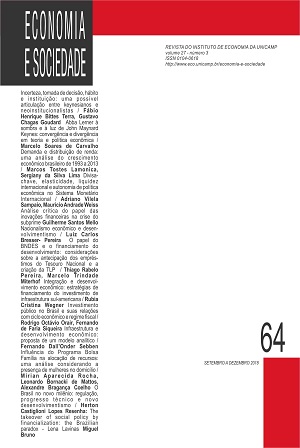Abstract
The article discusses the decision of the Brazilian government to prepay R$ 280 billion in Treasury loans to the BNDES and also to index the cost of BNDES funding to a 5-year market rate indexed to IPCA, through the substitution of TJLP for the new TLP. In addition to the legal aspects, the allocative and economic implications are assessed. It is argued that the traditional view, which circumscribes the mission of a development bank to the correction of deviations between the social and private return of projects intensive in externalities, should be combined with a vision emphasizing the stabilizing character, via the credit channel, of a development bank, acting in a relevant systemic scale, as a tool to offset the pro-cyclical and short term propensities of private finance. Furthermore, we should consider its contribution to development through the mitigation of the extreme severity of long-term credit rationing over private investment in Brazil linked to the historically high interest rates, that removes a bias against capital intensive projects and those with significant potential scale economies. The paper emphasizes the need for an evaluation of both the costs and the fiscal benefits derived from the banks' contribution to economic growth and financial stability. It also proposes a change in the rule of formation of the new TLP such as to preserve some degree of flexibility required for policy makers to be able to react to the challenges posed to monetary and credit policies in different economic contexts.
References
BERNANKE, Ben. The Federal Reserve and the Financial Crises – Lectures by Ben Bernanke. Princeton University Press, 2013.
BOLLE, Mônica Baumgarten de. do public development banks hurt growth? evidence from Brazil. Peterson Institute for International Economics – Policy Brief, Sept. 2015. Disponível em: https://piie.com/publications/pb/pb15-16.pdf.
BOLLE, Mônica Baumgarten de. O BNDES eleva a produtividade? Folha de S. Paulo, 3 set. 2015. Disponível em: http://www1.folha.uol.com.br/colunas/monica-debolle/2015/09/1677109-o-bndes-eleva-a-produtividade.shtml.
CUSTO Líquido dos Empréstimos do Tesouro ao BNDES. Nota conjunta APE a AF, BNDES, ago. 2015. Disponível em: https://www.bndes.gov.br/SiteBNDES/export/sites/default/ bndes_pt/Galerias/Arquivos/empresa/download/Custo_Liquido_Emprestimos_Tesouro_BND ES.pdf.
FERRAZ, João Carlos; MARQUES, Felipe Silveira; LEAL, Cláudio Figueiredo; MITERHOF, Marcelo Trindade. Financing development: the case of BNDES. In: STIGLITZ, J.; JUSTIN, Lin (Ed.). The industrial policy revolution I: the role of government beyond ideology. Pallgrave Macmillan, 2013.
GRIFFITH-JONES, S. Development banks and their key roles: supporting investment, structural transformation and sustainable development. Bread for the World, 2016. (Discussion Paper, n. 59). Disponível: http://www.stephanygj.net/papers/Development_ banks_and_their_key_roles_2016.pdf.
GRIFFITH-JONES, S.; COZZI, G. The roles of development banks; how they can promote investment, in Europe and globally. In: NOMAN, A.; STIGLITZ, J. (Ed.). Efficiency, finance, and varieties of industrial policy: guiding resources, learning, and technology for sustained growth. Columbia University Press, 2016. Dispinível em:
http://www.stephanygj.net/papers/The_roles_of_development_banks_how_they_can_promot e_investment_in_Europe_and_globally_2016.pdf.
KAWALL, Carlos. Dinâmica da dívida bruta. Apresentação Banco Safra, 2015. Disponível em: http://iepecdg.com.br/wp-content/uploads/2016/03/Carlos_Estudo_Divida-1.ppt.
LAZZARINI, Sergio et al. What do state-owned development banks do? Evidence from BNDES, 2002- 2009. World Development, n. 66, p. 237-256, 2015.
LOPES, Francisco. The transmission mechanism of monetary policy in a stabilizing economy: notes on the case of Brazil. Basle: BIS, Jan. 1998. (Policy Papers, n. 3). Disponível em: https://www.bis.org/publ/plcy03.pdf.
MACHADO, Luciano; GRIMALDI, Daniel; ALBUQUERQUE, Breno; SANTOS, Leonardo. Additionality of countercyclical credit: evaluating the impact of BNDES’ PSI on the investment of industrial firms. nov. 2014. (Working Paper). Disponível em: https://www.bndes.gov.br/SiteBNDES/export/sites/default/bndes_pt/Galerias/Arquivos/conhe cimento/efetividade/additionality_of_countercyclical_credit.pdf.
MAZZUCATTO, Mariana. The entrepreneurial state – debunking public vs. private sector myths. Public Affairs, New York, 2015.
MEHRLING, Perry. The New Lombard Street: how the Fed became the dealer of last resort. Princeton University Press, 2010.
MITERHOF, Marcelo Trindade; FERRAZ, João Carlos; MARQUES, Felipe Silveira. BNDES: preenchendo lacunas, corrigindo falhas e induzindo externalidades. In: BARBOSA. Nelson et al. (Org.). Indústria e desenvolvimento produtivo no Brasil. Rio de Janeiro: Elsevier; FGV, 2015. p. 467-483.
MODENESI, André de Melo; Araújo, Eliane Cristina de. Price stability under inflation targeting in Brazil: empirical analysis of the monetary policy transmission mechanism based on var model, 2000-2008”. Investigación Económica, v. LXXII, n. 283, p. 95-127, Jan./Mar. 2013.
PEREIRA, Thiago Rabelo; SIMÕES, Adriano; CARVALHAL, André. Mensurando o resultado fiscal das operações de empréstimo do Tesouro ao BNDES: custo ou ganho líquido esperado para a União? Rio de Janeiro: Ipea, set. 2011. (Texto para Discussão, n. 1665). Disponível em: http://repositorio.ipea.gov.br/bitstream/11058/1184/1/td_1665.pdf.
RELATÓRIO trimestral de prestação de contas ao Congresso Nacional sobre o uso dos recursos Emprestados pelo Tesouro ao BNDES. Disponível em: https://www.bndes.gov.br/SiteBNDES/export/sites/default/bndes_pt/Galerias/Arquivos/empr esa/download/Relatorio_Recursos_Financeiros_4trimestre2015.pdf.
RELATÓRIO de efetividade 2007-2014: a Contribuição do BNDES para o Desenvolvimento Nacional. Disponível em: https://www.bndes.gov.br/SiteBNDES/export/sites/default/ bndes_pt/, http://www.valor.com.br/financas/4527647/para-stiglitz-criticas-atuacao-dobndes-dificultam-retomada.
SIFFERT Filho, Nelson Fontes; PUGA, Fernando Pimentel. A infraestrutura de transporte nos Estados Unidos: em busca do funding. Rio de Janeiro: BNDES, dez. 2016. (Texto para Discussão, n. 113). Disponível em: https://web.bndes.gov.br/bib/jspui/bitstream/ 1408/10416/1/TD_113_dez.%202016_P.pdf.
STIGLITZ, Joseph E.; WEISS, Andrew. Credit rationing in markets with imperfect information. The American Economic Review, v. 71, n. 3, p. 393-410, Jun. 1981.
A Economia e Sociedade utiliza a licença do Creative Commons (CC), preservando assim, a integridade dos artigos em ambiente de acesso aberto.


